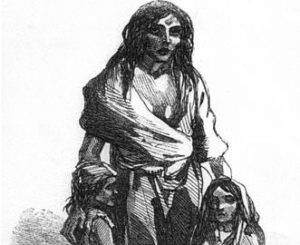
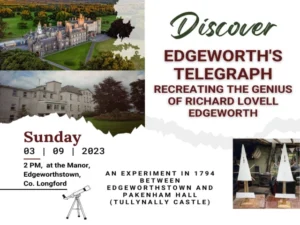

Philip Brady enthusiastically shares his experience of our recreation of Edgeworth’s Telegraph! On Sunday, September 3, 2023, we successfully duplicated the transmission of a signal, thanks to the outstanding teamwork led by Ray Jordan. Dive into the details of the original event and Edgeworth’s Telegraph – learn more here!
The young man laughed loudly to himself and then started talking. There was no one else there. He approached the gate to ask directions, removed an ear plug from his ear, and then I understood. Technology is wonderful, I said, looking at the smart phone. Yes, he said, I was talking to a friend in West Australia.
That all started here I said, pointing towards the town, in the Big House there, The Manor. Richard Lovell Edgeworth, scientist and inventor, and father of the novelist Maria, started it with his Semaphore.
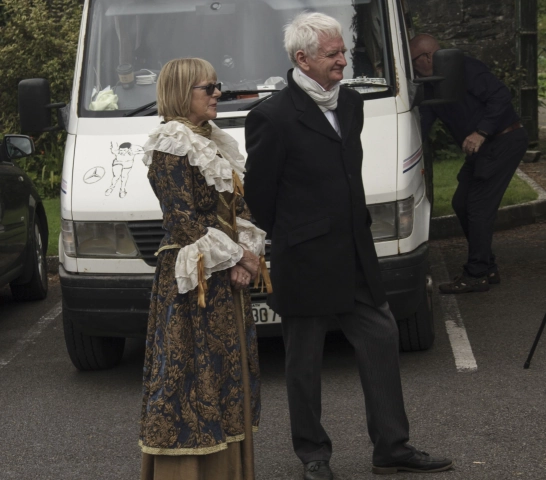
The young man asking the directions was going to Ballinamuck he said, where they planned a re-enactment of the Battle in 1798 for its 225th anniversary. Interesting, I thought, and I am home for the re-enactment of the first message sent from here to the Big House at Tullynally Castle with Richard Lovell’s new apparatus, The Semaphore. It was a system of discs and levers, each in view of the other on elevated positions and using rotating angular pointers to send messages from Galway back to Dublin, and I am here to see it working I said. We parted, he with his directions, heading towards North Longford, and I heading back to The Big House, The Manor, with its many happy memories.
In the car park facing the Main Street I wondered was it here they parked their traps and coaches, for their horses to be fed and watered, in days of visitation, and wondered who might be here today visiting. We walked around The Big House, once a school, now a Nursing Home, on the path the processions used in former days on their route through the forest. At the front door stood a lady of distinction, in full length embroidered elegance. Could this be Lady Clonbroney coming to meet us, but No, she smiled, and with a welcome and familiar accent, one of the committee recreating history, came forward with a greeting.
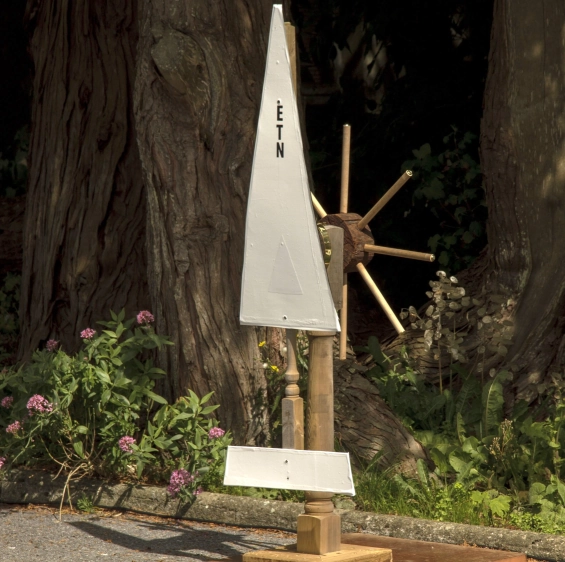
She pointed out the Semaphore, a large Rotating Disc with Triangular Pointers on a guide wheel like a ship’s Helm. Beside it stood a man of some importance going through his briefing papers. Walter Scott I ventured, on a visit from Abbotsford, but no, It was the chairman, again extending a welcome. Studiously bending over an apparatus, busily making adjustments and calculations was another man in a tightly fitting waist coat of the latest fashion. Hamilton the mathematician, I thought, for he used to visit, but then he turned in triumph to declare that he was almost ready. He had made the last adjustments to his screen and zoom system. How Richard Lovell would have chuckled and would have
approved of this new technology that changed our Post-Covid world now explaining his 17th century communications system.
We were shown to our seats and furms, under the kindly gaze of the Big House Bay Window. We faced the overgrown path that once led into the woods and led directly to the parsonage where the Abbe Edgeworth was born. To the right was the road to Castlepollard and to Tullynally Castle. The lecture and the demonstration had started. The numbers on the dial were 15 degrees apart , starting with zero at the apex. Each 15-degree rotation represented each consecutive number. The camera at Tullynally beamed its photograph on to the screen, a similar device of rotating pointers ready to transmit and ready to receive. Each apparatus would be in view of each other, on an elevated platform, in a line across the country. They would receive and acknowledge. Today was a special day, to say hello to friends at Tullynally.
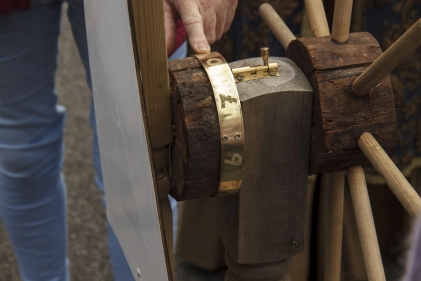
To start, the pointer, pointing straight downwards to 90 degrees was moved to and fro three times to ask if seen, and the observing pointer answered with the same movements. Next to pass on a message. The pointer rotated to position 45 degrees. That is easy, position 3 on the dial. The answer came back, confirming the same position, so it had been seen and noted. Quickly a code of digits were transmitted and confirmed. Next the code was taken to a catalogue of words, phrases and sentences.
The code was quickly deciphered and read. “Greetings from Tullynally”. Excellent. When the message ended the pointer was waved back and forth to indicate completion and answered in the same way to indicate understood.
Next to transmit another message. The same process started, the same message reciprocated. But suddenly a problem. The TV screen became temperamental and flickered. How appropriate for today the speaker said. The difficulty with the Semaphore was that when the weather was poor or visibility impaired by fog it would not be seen properly. Richard Lovell would be amused and would love to see that his difficulties were being reproduced authentically.
He wanted the authorities to use it for defence and other military purposes. The French had been active and been in contact with the rebels, and an invasion was possible. This would send messages across the country more quickly than any means of transport or of travel. Down at the old School House is the dictionary that Richard Lovell used and notated with codes for the words and phrases most useful for these purposes. It was in that old schoolhouse that Master Hyland first told us about Richard Lovell’s road making techniques that he advanced long before they were implemented. He showed us too the ancient roadway from Rathcroghan in Connaught to the seat of the High Kings at Tara, and where it ran by the ancient Abbey, beyond the school but long since destroyed.
But back from the distant past, to the current century, for the Semaphore is working again and the Ladies and Gentlemen are paying full attention. Another message is being sent out from Tullynally Castle. The angles were pointed to the appropriate figures and confirmed. The message completed and pointers moved to and fro to confirm completion. The figures could be plainly identified, and now to decode the message and translate from the code book.
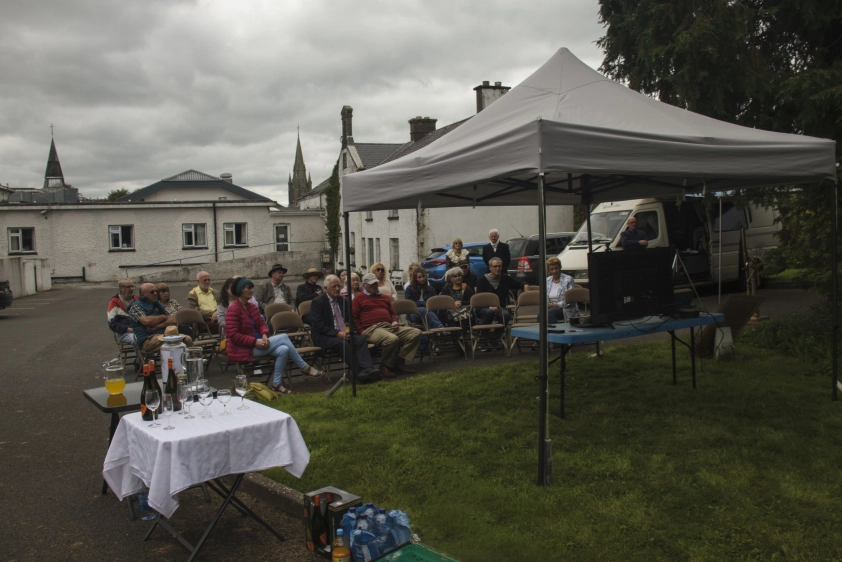
The Code Book was produced and the News item for transmission was read out. “The French are in Ballinamuck” it said. I had visions of the Rebels running across the fields of North Longford to meet General Humbert on his way from Castlebar. The progress of Humbert’s army was being monitored from one side of the country to the other, through outposts at Arden, and Knockdrin to Dublin. And then I thought of the young man with the ear plugs and the smart phone. He would probably have gone through Firmount and Clonbroney by now, and was looking up a signpost that said Drumlish, wondering which road to take, lost in a google-map confusion, not knowing that the message sent by Semaphore was long there before him.
Beaming success, the session ended and the assembled audience were seamlessly transformed into enthusiastic groups of neighbourly conversations. A young man, a stranger, who had moved to the front row to view the demonstration, asked about The House and moved quietly away to inspect and absorb the surroundings.
I joined The Distinguished Chairman and The Technical Man with the waistcoat. They were poring over an ancient map. This should interest you they said. These are the communication posts and there was one at Shean and Knockdrin near Edenderry. I was immediately drawn to the names and their significance, each an estimation of the original Irish placename. Shean means a Fairy Mound, now a sand quarry on an Esker and Knockdrin means The Hill of Conflict, standing upright in the centre of a Bog Plain. They form a triangle with another outpost Arden, which means High Place and is remembered in many Tullamore place names. Each is roughly equidistant, on high ground, within sight of each other and on a route from the West Coast to Dublin Headquarters. “You had a talk last year at The Maria Edgeworth Festival about Balloon experiments” I said. “Was it to establish these high landmarks for defence” I enquired.
The young man arriving back from his journey around The House and grounds excused himself to enquire “which way was the way to Castlepollard”. “Right and Right again” I pointed out “and about fourteen miles straight ahead as the crow flies”, “or as the Semaphore flies” said the man in the waistcoat helpfully. The young man left smiling but with a mobile phone within reach on his way to Tullynally. “About the Balloon experiment” the Chairman said resuming our conversation, but Lady Clonbroney was interrupting, offering Tea and freshly baked scones, in a friendly Edgeworthstown accent.
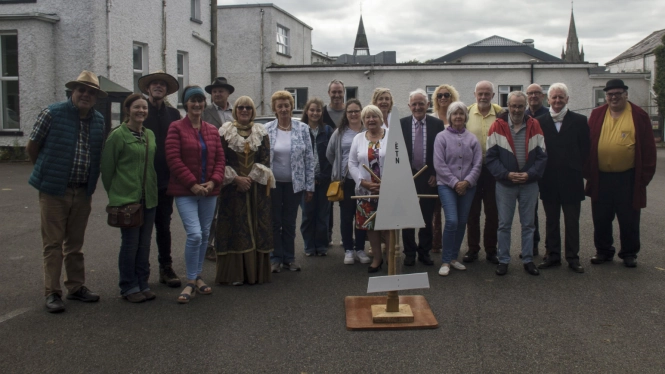
I think that I’ll have to come back to The Festival in May to learn more about this fascinating era of discovery.
Written by Philip Brady
The best way to keep in touch and to be aware of our events
Don’t forget to confirm your subscription in the Email we just sent you!

Please pre-book your visit over Christmas at least 24h in advance via Email or Online booking.
MondayClosed
Tuesday10:00 AM - 5:00 PM
Wednesday10:00 AM - 5:00 PM
Thursday10:00 AM - 5:00 PM
Friday10:00 AM - 5:00 PM
Saturday11:00 AM - 5:00 PM
Sunday11:00 AM - 5:00 PM
Adult €7.50
Children 10 to 16 €3
2 Adults & 2 Children €15
Adult is 16 years+
Family Ticket is 4 family members together
Children under ten are free but must be accompanied by an Adult

The Maria Edgeworth Centre is operated under the direction of the Edgeworthstown District Development Association (EDDA) – a Not for Profit Voluntary Community based registered charity Reg:223373. Registered Charity Number 20101916
© 2023 Maria Edgeworth Centre – All Rights Reserved
On the 17th of August 2024 as part of Heritage Week, with support from the County Heritage Officers, the Heritage Council, Longford County Council Libraries, Archives, Arts and Heritage,
IMMA, OPW and the Computer and Communications Museum Ireland on the NUIG Campus,
Ray Jordan and volunteers from the Maria Edgeworth Centre aim to simulate Edgeworth’s 1803 transmission by telegraph.
Click the link below to learn more or to register to attend either in person or via Zoom.
Join us for this recreation of a key moment in the history of communications